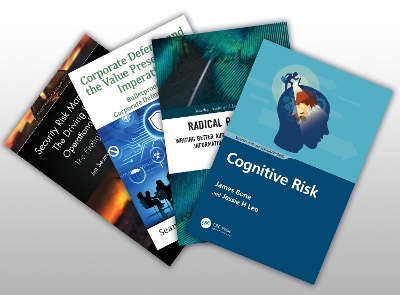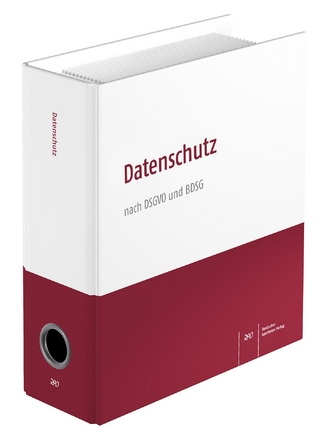
Four-Book Set on Risk Management
CRC Press
978-1-032-96812-4 (ISBN)
- Titel z.Zt. nicht lieferbar
- Versandkostenfrei
- Auch auf Rechnung
- Artikel merken
Corporate Defense and the Value Preservation Imperative is the first book to finally address the umbrella term corporate defense, and to explain how an integrated corporate defense program can help an organization address both value creation and preservation. The book explores the value preservation imperative, which represents an organization’s obligation to implement a comprehensive corporate defense program in order to deliver long-term sustainable value to its stakeholders. For the first time the reader is provided with a complete picture of how corporate defense operates all the way from the boardroom to the front-lines, and vice versa. It provides comprehensive guidance on how to implement a robust corporate defense program by addressing this challenge from strategic, tactical, and operational perspectives. This arrangement provides readers with a holistic view of corporate defense and incorporates the management of the eight critical corporate defense components. It includes how an organization needs to integrate its governance, risk, compliance, intelligence, security, resilience, controls and assurance activities within its corporate defense program.
Radical Reporting, this small volume provides the tools and techniques needed to improve reports. It does so through addressing crucial concepts all too often overlooked in the familiar rush to perform tasks, complete projects, and meet deadlines.
These concepts – the role of culture in communication; the link between logic and language; the importance of organizing thoughts before writing; and how to achieve clarity – may seem academic or theoretical. They’re not. Unless writers understand their own thoughts, actions, and objectives, they cannot hope to communicate them at all – let alone clearly.
Cognitive Risk is a book about the least understood but most pervasive risk to mankind – human decision-making. Cognitive risks are subconscious and unconscious influence factors on human decision-making: heuristics and biases. To understand the scope of cognitive risk, we look at case studies, corporate and organizational failure, and the science that explains why we systemically make errors in judgment and repeat the same errors.
In Security Risk Management - The Driving Force for Operational Resilience, we change the perspective on an organization’s operational resilience capabilities so that it shifts from being a reactive (tick box) approach to being proactive. The perspectives of every chapter in this book focus on risk profiles and how your business can reduce these profiles using effective mitigation measures.
The book is divided into two sections:
1. Security Risk Management (SRM).
All the components of security risk management contribute to your organization’s operational resilience capabilities, to help reduce your risks.
• Reduce the probability/ likelihood.
2. Survive to Operate.
If your SRM capabilities fail your organization, these are the components that are needed to allow you to quickly ‘bounce back.’
• Reduce the severity/ impact.
Sean Lyons is globally recognized as a corporate defense thought leader and strategist. He is acknowledged as the pioneer responsible for proposing the umbrella term "Corporate Defense" to represent an organization’s collective program for self-defense, and also for being the first person to propose the extended "Five Lines of Defense" oversight model which is currently receiving increasing levels of regulatory attention. Sean is published internationally, and has lectured and spoken as a subject matter expert at lectures, seminars, and conferences in Europe, North America, and Asia. These speaking engagements include topics such as corporate governance, enterprise risk management (ERM), compliance, security, business continuity, internal controls, assurance, and governance, risk and compliance (GRC). His work on corporate defense has been cited in a number of books and multitude of other publications on the above topics. Sara I. James is an internationally recognized expert in internal audit communications, delivering tailored report-writing and other training to internal audit, risk and compliance teams worldwide (www.saraijames.com). With over 30 years' academic, teaching, writing, publishing and corporate experience in the US and Europe, she brings a wealth of varied yet specialist expertise to clients and audiences. Clients include multinational blue-chip organizations in sectors as diverse as finance, oil and gas, pharmaceuticals and aerospace; national and local government; legal and medical professionals; and charities. As a member of the Chartered Institute of Internal Auditors (UK and Ireland) Technical Guidance Working Group, Sara has produced many governance, risk and internal audit advisory pieces. James Bone is president of Global Compliance Associates, LLC, an enterprise risk researcher and the first cognitive risk consultant. Since the publication of his first book Cognitive Hack, James has promoted the idea of a cognitive risk framework in several publications and has developed a following on social media as a thought leader in this space. James has also served as lecturer-in-discipline, Enterprise Risk Management at Columbia University School of Professional Studies. Cognitive Risk will be the first book of its kind to apply additional research and experience through case studies to formulate a more complete cognitive risk framework for cybersecurity and enterprise risk management. James has two websites, globalcomplianceassociates.com and thegrcbluebook.com, that will be used to promote the book as well as 5,000 - 8,000 fellow global risk professionals seeking thought leadership in risk best practices. Jessie H. Lee has 25+ years of leadership experience in the financial, government, higher education, and nonprofit sectors. Jessie is a strategic and insightful leader who enables organizations to transform and grow through innovative and inclusive approaches integrating enterprise risk management, technology, and data to strengthen financial and operational sustainability and flexibility. She employs data-driven approaches and builds collaborative and trusted relationships with boards, executive leaders, staff, strategic partners, and industry leaders. She founded Better Future Strategies LLC to enable nonprofit and social enterprise organizations to achieve their visions. She teaches courses in both Enterprise Risk Management and Nonprofit Management Masters programs at Columbia University. Jim Seaman honed his skills and craft during a 22-year career in the Royal Air Force Police, with the final decade being employed on Counter Intelligence, Computer Security, Counter Terrorism and Risk Management duties. On completion of his 22-years of military service, he sought the new challenge of transferring his specialist skills and knowledge across to the corporate sector. In the decade since transitioning across to the corporate environment, he has fulfilled roles within Payment Card Industry Data Security Standard (PCI D)SS compliance, data protection, information security, industrial systems security and risk management. In the past few years, he has sought to further develop his knowledge and to rise to the challenge of authoring two books, one on the subject of PCI DSS (published May 2020) and the other on Protective Security (published Apr 2021). Michael Gioia is an information security leader with over 18 years of experience delivering security solutions across several industries. He has served as an officer in the United States Air Force and worked in higher education, the Department of Defense, retail food services, and security consulting. He has performed most of his information security work within higher education, currently, as the Chief Information Security Officer (CISO) for Babson College and formerly as the Information Security Officer (ISO) at Eastern Illinois University, Rose-Hulman Institute of Technology, and Bentley University. He retains various professional certifications that include a Certified Information Security Manager (CISM) and Certified Data Privacy Solutions Engineer (CDPSE) from ISACA, Certified Information System Security Professional (CISSP) from ISC2, GIAC Security Leadership Certification (GSLC) from SANS, and Payment Card Industry Professional (PCIP) from the PCI Security Standards Council.
Corporate Defense and the Value Preservation Imperative
SECTION I – A Strategic Perspective. Business Strategy and Value Preservation. The Corporate Defense Landscape. Value Preservation and the Corporate Defense Initiative. The Corporate Defense Program and Strategy. SECTION II – A Tactical Perspective. Laying the Foundation and Setting the Ground Rules. An Enterprise-wide Approach to Corporate Defense. Oversight and the Five Lines of Corporate Defense. Managing the Critical Corporate Defense Components. Critical Corporate Defense Components (Part I). Critical Corporate Defense Components (Part II). Developments in Approaches to Corporate Defense. The Corporate Defense Management Framework. SECTION III – An Operational Perspective. Inside the CDM Framework. Application of the CDM Philosophy in Practice. Delivering the Corporate Defense Program. Organizational, Technological, and Future Challenges. SECTION IV – An Integrated Perspective. The Corporate Defense Value Proposition. In Conclusion.
Radical Reporting
Acknowledgements. Author. Introduction. Part 1: Words in the mind. Chapter 1: Communication and culture. Chapter 2: Communication within and among teams. Chapter 3: Clarity – the theory. Part 2: Words on the page. Chapter 4: Clarity – the practice. Chapter 5: Planning. Chapter 6: Structure and layout. Part 3: Words into action. Chapter 7: Findings or observations, and recommendations. Chapter 8: Executive summaries. Chapter 9: Reviewing – making the gain outweigh the pain. Conclusion. Resources.
Cognitive Risk
1. Reimagining the Organization: Homo Periculum (Human Risk), 2. Complexity in Risk and Risk Perceptions, 3. A Matrix of Risk Governance – Organizational Behavior, 4. Incorporating Human Risk Factors into Organizational Performance, 5. How Emotions Mislead Decision-Makers, 6. Cognitive Readiness – Risk-Solution Designers, 7. The Human Element, 8. Cognitive Risk Governance: Advanced ERM and Cybersecurity.
Security Risk Management - The Driving Force for Operational Resilience
Section One: Security Risk Management Reducing the Likelihood/Probability, 1. Finagling Your Business, 2. Business Impact Analysis, 3. Asset Management, 4. Risk-Based Vulnerability Management, 5. Threat Management, 6. Risk Scenarios, 7. Quality Versus Quantity, 8. Developing a Risk Culture, 9. Risk-Enabling the Human Firewall, 10. Risk-Based Security Operations, 11. Creating Visibility and Insights Through Effective Security Risk Metrics, Section Two: Survive to Operate: Reducing the Impacts/Consequences, 12. Security Incident Management, 13. Business Continuity Management, 14. Disaster Recovery Management.
| Erscheint lt. Verlag | 20.9.2024 |
|---|---|
| Reihe/Serie | Security, Audit and Leadership Series |
| Zusatzinfo | 67 Tables, black and white; 140 Illustrations, black and white |
| Verlagsort | London |
| Sprache | englisch |
| Maße | 156 x 234 mm |
| Gewicht | 2090 g |
| Themenwelt | Informatik ► Netzwerke ► Sicherheit / Firewall |
| Wirtschaft ► Betriebswirtschaft / Management ► Logistik / Produktion | |
| Wirtschaft ► Betriebswirtschaft / Management ► Unternehmensführung / Management | |
| ISBN-10 | 1-032-96812-5 / 1032968125 |
| ISBN-13 | 978-1-032-96812-4 / 9781032968124 |
| Zustand | Neuware |
| Haben Sie eine Frage zum Produkt? |
aus dem Bereich


